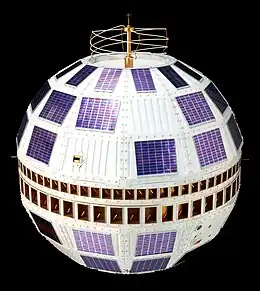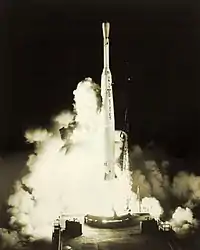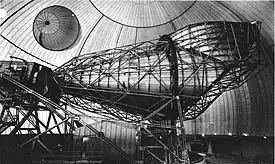 The original Telstar had a roughly spherical shape. | |
| Operator | AT&T / NASA |
|---|---|
| COSPAR ID | 1962-029A[1] |
| SATCAT no. | 340 |
| Mission duration | 7 months and 11 days |
| Spacecraft properties | |
| Manufacturer | Bell Labs |
| Launch mass | 171 pounds (78 kg) |
| Start of mission | |
| Launch date | 08:35:00, July 10, 1962 (UTC) |
| Rocket | Thor-Delta |
| Launch site | Cape Canaveral LC-17B |
| End of mission | |
| Deactivated | February 21, 1963 |
| Orbital parameters | |
| Reference system | Geocentric |
| Regime | Medium Earth |
| Perigee altitude | 952 kilometers (592 mi) |
| Apogee altitude | 5,933 kilometers (3,687 mi) |
| Inclination | 44.8° |
| Period | 2 hours and 37 minutes |
| Epoch | 1962-07-10 08:35:00 UTC |
| External audio | |
|---|---|
Telstar 1 is a defunct communications satellite launched by NASA on July 10, 1962. It was the satellite that allowed the first live broadcast of television images between the United States and Europe. Telstar 1 remained active for only 7 months before it prematurely failed due to Starfish Prime, a high-altitude nuclear test conducted by the United States. Although the satellite is no longer operational, it remains in Earth orbit.
History


The idea of transmitting information by means of satellites was hardly new. As early as October 1945, the visionary Arthur C. Clarke published an article talking about it in the specialized magazine Wireless World. His idea was to take advantage of the immensity of space to transmit information, using a satellite system for this purpose. During the Cold War, the shock caused by the successful launch of the first artificial satellite, Sputnik 1, by the Soviets increased the United States' interest in aerospace research. Soon thereafter, the Americans began their attempts to launch orbital communications satellites for transmitting telephone, radio, and television signals.[3]
In December 1958, the United States successfully launched its first communications satellite, SCORE. Through it, then-President Dwight D. Eisenhower sent a Christmas message to the entire world. However, SCORE stayed in orbit for only a few months, its enormous surface area and very low Earth orbit forcing reentry after only 500 laps around the planet due to aerodynamic resistance. Also, SCORE relied on a passive reflector, which greatly reduced signal strength, since it did not amplify the signal before sending it back to earth.
Launch
Telstar 1 was launched on July 10, 1962, from the Cape Canaveral Air Force Station, Florida, atop a Delta rocket. Spherical in shape, the satellite had a diameter of 88 centimetres (35 in) and weighed 77 kilograms (170 lb).
Operations
A 53-meter terrestrial antenna manufactured by AT&T Corporation, located in Andover, Maine, was used for the transmissions between the United States and Europe. Built in 1961, and used by Telstar 1, it was later used by Relay 1. Telstar 1 operated normally from launch until November 1962 when the radiation from the Starfish Prime detonation affected the command channel, which began to behave erratically. The satellite was continuously switched on to work around this problem. On November 23, 1962, the command channel stopped responding. On December 20, the satellite was successfully reactivated, and intermittent data were obtained until February 21, 1963, when the transmitter failed. The energy used by it was produced by 3,600 solar cells. The satellite relied on an active repeater and magnified signal strength by a factor of a hundred using a travelling wave tube amplifier (TWTA). Thirteen days after the launch, the first live broadcast of a television show between the United States and Europe took place.[4]: 3-5
Broadcasting
Telstar 1 relayed its first, and non-public, television pictures—a flag outside Andover Earth Station—to Pleumeur-Bodou on July 11, 1962.[5] Almost two weeks later, on July 23, at 3:00 p.m. EDT, it relayed the first publicly available live transatlantic television signal.[6] The broadcast was shown in Europe by Eurovision and in North America by NBC, CBS, ABC, and the CBC.[6] The first public broadcast featured CBS's Walter Cronkite and NBC's Chet Huntley in New York, and the BBC's Richard Dimbleby in Brussels.[6] The first pictures were the Statue of Liberty in New York and the Eiffel Tower in Paris.[6] The first broadcast was to have included remarks by President John F. Kennedy, but the signal was acquired before the president was ready, so engineers filled the lead-in time with a short segment of a televised game between the Philadelphia Phillies and the Chicago Cubs at Wrigley Field.[6][7][8] The Phillies' second baseman Tony Taylor was seen hitting a ball pitched by the Cubs' Cal Koonce to deep right field, caught by fielder George Altman for the out. From there, the video switched first to Washington, DC; then to Cape Canaveral, Florida; to the Seattle World's Fair; then to Quebec and finally to Stratford, Ontario.[6] The Washington segment included remarks by President Kennedy,[7] talking about the price of the American dollar, which was causing concern in Europe. When Kennedy denied that the United States would devalue the dollar it immediately strengthened on world markets; Cronkite later said that "we all glimpsed something of the true power of the instrument we had wrought."[6][9]
That evening, Telstar 1 also relayed the first satellite telephone call, between U.S. vice-president Lyndon Johnson and the chairman of AT&T, Frederick Kappel. It successfully transmitted faxes, data, and both live and taped television, including the first live transmission of television across an ocean from Andover, Maine, US, to Goonhilly Downs, England, and Pleumeur-Bodou, France.[10] (An experimental passive satellite, Echo 1, had been used to reflect and redirect communications signals two years earlier, in 1960.) In August 1962, Telstar 1 became the first satellite used to synchronize time between two continents, bringing the United Kingdom and the United States to within 1 microsecond of each other (previous efforts were accurate to only 2,000 microseconds).[11]
The Telstar 1 satellite also relayed computer data between two IBM 1401 computers. The test, performed on October 25, 1962, sent a message from a transmitting computer in Endicott, New York, to the earth station in Andover, Maine. The message was relayed to the earth station in France, where it was decoded by a second IBM 1401 in La Gaude, France.[12]References
- ↑ NASA, Goddard Space Flight Center. "Telstar 1". National Space Science Data Center Master Catalog. Retrieved 31 May 2018.
- ↑ Quarles, Philip (7 September 2018). "Felker Talking Telstar". WNYC. Archived from the original on 29 May 2023. Retrieved 11 November 2023.
- ↑ Feldkeller, Klaus (n.d.). "1962: Nasa lança ao espaço o primeiro satélite de comunicações" [1962: NASA launches the first communications satellite]. Deutsche Welle (in Portuguese). Archived from the original on 18 August 2022. Retrieved 28 November 2023.
- ↑ Dalgleish, Don I. (30 June 1989). "1: The development of satellite communication". An Introduction to Satellite Communications. Institution of Electrical Engineers. ISBN 978-0863411328. LCCN 89168323. OCLC 23238420. OL 2277460M. Retrieved 28 November 2023 – via Google Books.
- ↑ "IEEE History Center: First Transatlantic Transmission of a Television Signal via Satellite, 1962". IEEE History Center. 2002. Retrieved 23 July 2009.
- 1 2 3 4 5 6 7 Walter Cronkite. "Telstar". NPR. Retrieved 23 July 2009.
- 1 2 Clary, Gregory (13 July 2012). "50th anniversary of satellite Telstar celebrated". Light Years (blog). CNN. Retrieved 15 July 2012.
- ↑ "Philadelphia Phillies vs Chicago Cubs". Box Score. Baseball-Almanac.com. 23 July 1962. Retrieved 15 July 2012.
- ↑ Telstar, Kennedy, and World Gold & Currency Markets, YouTube
- ↑ Video: A Day in History. Telstar Brings World Closer, 1962/07/12 (1962). Universal Newsreel. 1962. Retrieved 20 February 2012.
- ↑ "Significant Achievements in Space Communications and Navigation, 1958–1964" (PDF). NASA-SP-93. NASA. 1966. pp. 30–32. Retrieved 31 October 2009.
- ↑ "IBM Archives: IBM and Telstar". www.ibm.com. 23 January 2003. Retrieved 26 May 2019.
External links
- Telstar. N2yo.com
- Stamps and envelopes related to Telstar I Archived 2022-05-06 at the Wayback Machine. National Postal Museum